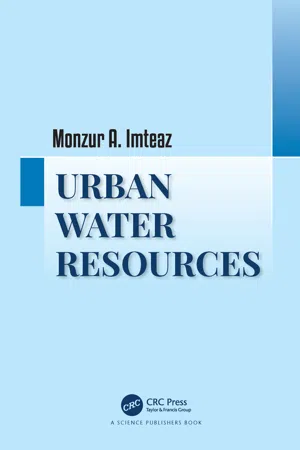
- 286 pages
- English
- ePUB (mobile friendly)
- Available on iOS & Android
Urban Water Resources
About This Book
Ever increasing urbanization is impacting both the quantity and quality of urban water resources. These urban water resources and components of the water cycle are likely to be affected severely. To minimize the consequences on world water resources, the development of sustainable water resources management strategies is inevitable. An integrated urban water resources management strategy is the key to maintain sustainable water resources. A preliminary understanding of physio-chemical processes and analysis methodologies involved in each and every component of the urban water cycle is necessary. In the past these components have been investigated and published individually.
With the view to aiding the development of integrated urban water resources management strategies, this book endeavors to present and explain the major urban water cycle components from a single holistic platform. The book presents the introduction, analysis and design methods of a wide range of urban water components i.e., rainfall, flood, drainage, water supply and waste water with the additions of sustainability practices in most of the components. Current "Hydrology" and "Hydraulics" books do not incorporate sustainability features and practices, while there are many books on general "Sustainability" without integrating sustainability concepts into typical engineering designs.
The book starts with components and classifications of world water resources, then basic and detailed components of the hydrologic cycle, climate change and its impacts on hydrologic cycle, rainfall patterns and measurements, rainfall losses, derivations of design rainfalls, streamflow measurements, flood frequency analysis and probabilistic flood estimations, deterministic flood estimations, unit hydrograph, flood modelling, commercial modelling tools and use of Geographical Information System (GIS) for flood modelling, principles of open channel hydraulics, critical flow and flow classification indices, open channel flow profiles, uniform flow in open channel and open channel design, estimation of future population and domestic water demand, design of water supply systems, sustainable water supply system, water treatments, wastewater quantification, wastewater treatments, sustainable and decentralized wastewater treatment, stormwater drainage and urban drainage analysis, water footprint and water-energy nexus, features of water conservation, harvesting and recycling, components of sustainable urban design, stormwater treatment and integrated water management.
Frequently asked questions
Information
Chapter
1
Introduction
1.1 World Water Resources

1.2 Classifications of Water Resources
- (a) Surface water
- (b) Ground water
- (c) Spring water
- (d) Frozen water
- (e) Ocean water
1.3 Climate and Climate Change
Table of contents
- Cover
- Title Page
- Copyright Page
- Dedication
- Acknowledgments
- Preface
- Table of Contents
- About the Author
- 1. Introduction
- 2. Hydrologie Cycle and Rainfall-Runoff Processes
- 3. Probabilistic Rainfall/Flood Estimation
- 4. Design Rainfall
- 5. Deterministic Flow/Flood Estimations
- 6. Open Channel Hydraulics
- 7. Uniform Flow in Open Channel
- 8. Hydraulic Modelling
- 9. Water Supply Systems
- 10. Wastewater Systems
- 11. Stormwater Drainage
- 12. Water Conservation and Recycling
- 13. Water Sensitive Urban Design
- Appendix A
- Appendix B
- Index
- Color Section